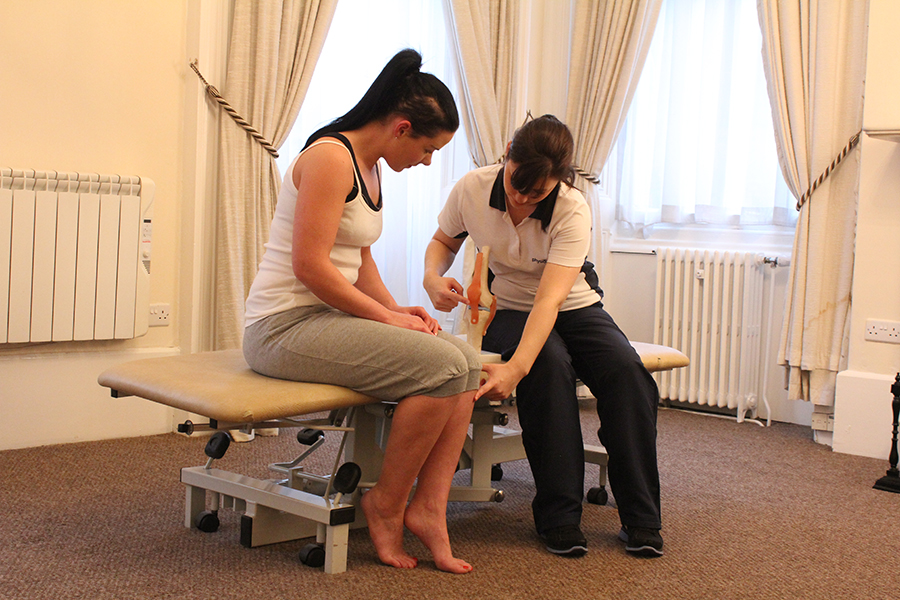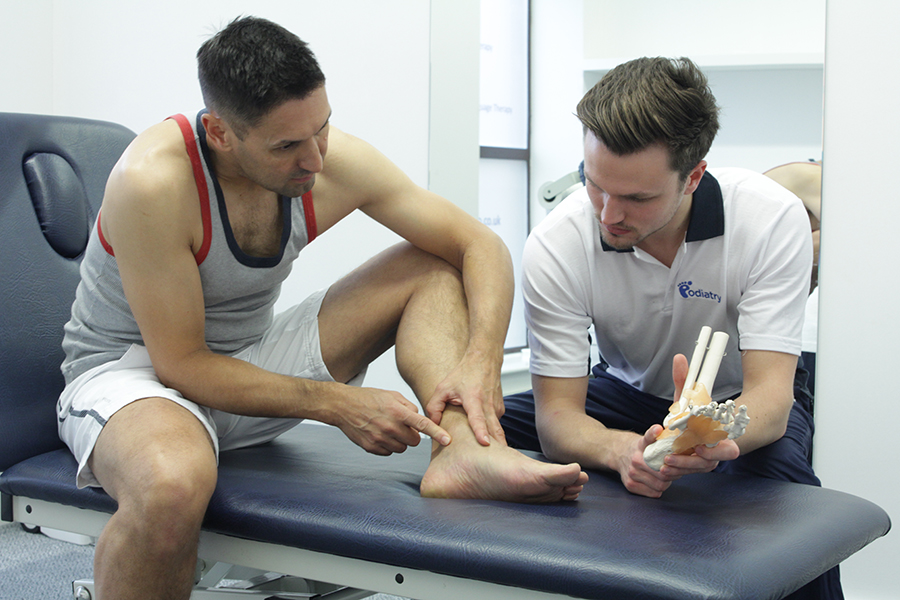Fractured ankle
A fractured ankle is an ankle that that has either broken or cracked. Ankle
fractures vary in severity and can involve any one of the three bones that
form the ankle joint, or combination of the three. It is important to have
an ankle fracture correctly diagnosed and treated appropriately. If you
suspect you have fractured your ankle you must visit A&E as soon as
possible.
Once an ankle fracture has healed podiatry can help with treatments
designed to improve the function of the foot and ankle.
What is a fractured ankle?
A fractured ankle describes an injury to the ankle that has caused there to be either a break or crack in any one of the bones that form the ankle. The bones that form the ankle are the tibia, fibula and talus. The most common site for an ankle fracture is on the outside of the ankle and involves the fibula.
What causes a fractured ankle?
A fractured ankle occurs when one or more of the bones that form the ankle cracks or breaks. A crack or a break of the ankle can be caused through, for example, a direct trauma, overuse, trip or fall, sporting impact or collision.

What are the signs and symptoms of a fractured ankle?
The signs and symptoms of a fractured ankle will appear quickly after
injury. Many people mistake an ankle fracture for an ankle sprain, however,
both an ankle sprain and ankle fracture can occur together. The signs and
symptoms of a fractured ankle include:
- Sudden onset of pain
- Swelling
- Bruising
- Difficulty weight-bearing
- Change in the way the ankle looks (compared to the other uninjured ankle)
- Bone, may be protruding from the skin
- A 'crack' or 'snap' may have been heard at the time of injury
If you think you may have fractured your ankle it is important that you seek immediate medical attention.
Types of fractured ankle
There are five main types of ankle fracture. Each fracture is named
according to the part of the ankle affected.
Lateral Malleolus Fracture
A lateral malleolus fracture is a fracture of the bony lump on the outside
of the ankle; this is called the lateral malleolus. The lateral malleolus
is part of the fibula, which is the bone on the outside of the leg and is
the smaller of the two lower leg bones. Lateral malleolus fractures are the
most common fractures affecting the ankle.
Medial Malleolus Fracture
A medial malleolus fracture is a fracture of the bony lump on the inside of
the ankle; this is called the medial malleolus. The medial malleolus is
part of the tibia, which is the larger of the two lower leg bones.
Posterior Malleolus Fracture
A posterior malleolus fracture is a fracture that occurs at the back of the
tibia (the shin), at the bottom.
Bimalleolar Fracture
A Bimalleolar fracture typically describes a fracture whereby both the
medial and lateral malleolus have been fractured. Alternatively it can also
describe two breaks of the ankle as 'bi' means 'two'.
Trimalleolar Fracture
A trimalleolar fracture involves both the medial and lateral malleolus, as
well as the back of the tibia (the end of the longer of the two bones that
make up the leg)
How are fractures of the ankle diagnosed?
A fracture of the ankle is typically diagnosed by X-ray. If you think you may have fractured your ankle you need to visit A&E or walk in centre so that an X-ray can be taken.

Benefits of podiatry following a fractured ankle
Following an ankle fracture podiatry can benefit you once any bracing or casting has been removed. Podiatric benefits following an ankle fracture include:
- Improved ankle joint range of motion
- Improved ankle flexibility and strength
- Reduced pain
- Improved gait and posture
Podiatric benefitscan be achieved through, for example, orthoses, which can
increase or compensate for any loss of ankle dorsiflexion (this is the
position the ankle is in when the toes point upwards.
Treatment using mobilisation will offer further benefits. Mobilisation
moves a joint through its range of motion, the movements are subtle and
allow the podiatrist to adjust the joint position with movement, which in
turn frees up the joint and improves its function. By combining orthoses
and mobilisation with a stretching programme and strengthening exercises
the ankle will become strong, flexible, and more resistant to fractures in
the future.
What would podiatry for a fractured ankle involve?
When the ankle has been fractured it takes time for the bone or bones to
heal. During the healing process the fracture may be immobilised in a cast
or other immobilizing device in order to keep the broken bones in place and
aid healing. When the ankle has been immobilised the muscles and ligaments
that make up the foot and ankle can stiffen, and this can impair function.
Podiatry can help you in your recovery from a fractured ankle by improving
the function of your foot and ankle, allowing you to get back to normal
activity.
The following treatments may be recommended by your podiatrist following a
fractured ankle:
All treatment is prescribed on an individual basis and therefore varies according to individual patient need.
Summary
An ankle fracture described a break or crack in one or more of the bones
that make up the ankle. Ankle fractures vary in severity and take time to
heal. During the healing process the ankle and foot may stiffen, and this
can inhibit it function. Podiatry can help you in your recovery by
providing treatment that helps to improve any lost function of the foot or
ankle as a result of your ankle fracture.
If you would like to arrange an assessment with us at Chiropody.co.uk
please Email office@chiropody.co.uk or call 0330 088 4222
Save 5% by booking an appointment online.



We work with:

Individuals

Organisations

Health professionals
Get in Touch!
0330 088 4222
If you would like to speak to one of our specialists then please complete this form.
We are open 7 days a week








